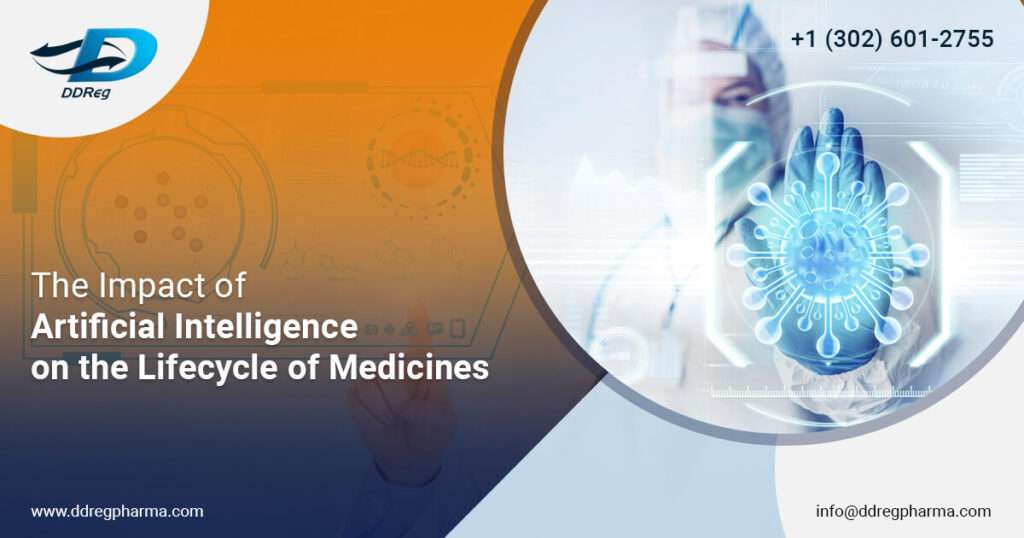The rapid digitalization of the biomedical and clinical research sectors has ushered in a new era of advancements, with artificial intelligence (AI) taking centre stage as a transformative solution. In particular, AI is revolutionizing drug discovery processes by harnessing the vast amount of data generated during molecule screening phases and preclinical studies. As a result, the global artificial intelligence in drug discovery market has witnessed remarkable growth, with a value of USD 1.1 billion in 2022, and is projected to expand at an impressive compound annual growth rate (CAGR) of 29.6% from 2023 to 2030.
Acknowledging the significance of AI in shaping the future of medicine, regulatory agencies have taken steps to provide guidance and ensure the safe and effective integration of AI in the drug development lifecycle. The European Medicines Agency (EMA) has published a draft reflection paper that outlines its current thinking on the use of AI to support the development, regulation, and usage of human and veterinary medicines. This reflection paper encompasses principles applicable to AI and machine learning (ML) at any stage of a medicine’s journey, from initial discovery to post-approval implementation.
The development of the reflection paper is a collaborative effort, driven by the joint HMA-EMA Big Data Steering Group (BDSG) initiatives, which aim to enhance the European Medicines Regulatory Network’s data-driven regulation capabilities. Working in conjunction with EMA’s Committee for Medicinal Products for Human Use (CHMP) and its Committee for Veterinary Medicinal Products (CVMP), the BDSG endeavours to harness the power of AI to usher in a new era of healthcare advancements while ensuring patient safety and efficacy.
The paper explores the profound implications of AI in drug discovery, shedding light on the synergistic partnership between human expertise and AI capabilities. It aims to empower researchers, regulators, and industry stakeholders with valuable insights into the potential applications of AI in drug discovery and the regulatory framework that ensures its ethical and responsible use.
Scope of AI and ML Applications
AI and ML technologies have a wide range of applications in clinical development. Some key areas include:
Data Management and Analysis:
AI/ML models play a crucial role in clinical trials by rapidly processing and analyzing large volumes of data. This leads to accelerated data-driven insights and quicker decision-making. By analyzing extensive patient data, these models can predict treatment responses and potential adverse events, which ultimately enables the adoption of personalized medicine approaches.
Patient Recruitment and Selection:
AI algorithms can help identify suitable candidates for clinical trials based on specific criteria, leading to more efficient and diverse patient recruitment.
Drug Discovery and Development:
AI can accelerate the drug discovery process by analyzing molecular structures, predicting drug-target interactions, and simulating drug-protein interactions.
Real-time Monitoring:
AI-powered devices can continuously monitor patients during clinical trials, providing real-time data for safety and efficacy evaluations.
Image and Speech Recognition:
AI-based image and speech recognition technologies can assist in the diagnostics and monitoring of diseases.
Regulatory Challenges
Despite the significant potential of AI/ML in clinical development, there are several regulatory challenges that need to be addressed:
Validation and Interpretability:
Regulators require AI/ML models to be validated thoroughly and their decision-making process to be transparent and interpretable.
Bias and Fairness:
Ensuring that AI/ML models do not exhibit bias and provide fair and equitable treatment to all patients is a crucial regulatory concern.
Data Privacy and Security:
With the use of sensitive patient data, ensuring data privacy and security is of utmost importance to comply with regulations and maintain patient trust.
Collaboration with Regulatory Authorities:
Developers need to engage early with regulatory authorities to ensure compliance and address any concerns related to the use of AI/ML in clinical trials.
Human-Centric Approach
Adopting a human-centric approach is essential when integrating AI/ML in clinical development. This approach should prioritize patient safety, ethical considerations, and respect for individual rights. AI/ML technologies should be designed to complement healthcare professionals’ expertise rather than replace them, enhancing the overall quality of patient care.
The Need for Regulatory Interactions
It is crucial to consider the regulatory impact and risk analysis for AI/ML applications in the medicinal product lifecycle. Applicants and developers are recommended to seek regulatory interactions when clear guidance is unavailable, especially in high-impact cases. Early interactions are facilitated by EMA’s specific task forces. Scientific advice and qualification for novel methodologies are available through designated working parties. The timing of interactions should align with the regulatory impact and risk. Critical reliance on AI/ML medical devices necessitates early regulatory interaction. Comprehensive documentation, including specific questions, is crucial for effective regulatory engagement.
Conclusion
AI and ML technologies have the potential to revolutionize clinical development, offering numerous opportunities to streamline processes, improve patient outcomes, and advance drug discovery. However, addressing regulatory challenges, prioritizing patient safety, and adopting a human-centric approach are essential to harness the full potential of AI/ML in clinical development. Through collaborative efforts between developers, regulators, and other stakeholders, the future of AI/ML in clinical development looks promising, ushering in a new era of innovative and personalized healthcare solutions.
References ad Further Reading
- Grand View Research. Artificial Intelligence in Drug Discovery. 2023
- EMA. Reflection paper on the use of Artificial Intelligence (AI) in the medicinal product lifecycle. European Medicines Agency. 2023

